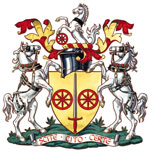
The Carmen’s story began long ago. Carriers have plied for hire for nearly two thousand years, since Rome came to Londinium. As medieval London grew, trade prospered on the wheels of Carmen. Ours is a story of mystery, intrigue, and mayhem.
Royal requirements, Rackets and Rubbish
Carmen existed when the City was born, moving goods and materials, wine, wood, and fuel, within and beyond the City. As the City grew and prospered so did the need for carts to move goods. Traditionally, the Carmen fellowship dates from the 13th century when, in 1272, the City passed a by-law controlling carriers. The Crown could force Carmen to handle Royal chattels and the pay was pitiful, so rackets developed, officials took bribes, Carmen were ‘excused’, and the City stepped in. Carters had to carry Royal and civic goods. The Carmen coped. They subcontracted to the suburbs, whence other carters came to take the City’s sewage.
Fraternyte of Carters

In 1517 the Carmen organised. They formed ‘the Fraternyte of Seynt Katryne the Virgyn and Marter of Carters’, and promised to furnish ‘the King’s carriages’, to ‘clense, purge and keep clene all the Stretes of …Donge’ and to carry ‘fewell…wynne, oyle, woads…within the said Citie and Suburbes’ at a reasonable price. In return they were granted the right of fellowship, but not of regulation. The City still ruled.
Woodmongers in charge

Carmen held standings or ‘carrooms’, where they plied for hire. So did Woodmongers. They wanted no part of the Carmen’s guild, so they bribed the Aldermen, overtook the Carmen, and dominated the trade. The City put Woodmongers in charge. The Carmen reacted – short of cash, they asked Christ’s Hospital to take over, in return for fees – they agreed.
In 1582 Christ’s Hospital accepted ‘the rule, charge and oversight…of Carts, Carres and Carmen’, provided an HQ, and helped ‘honest and painefull [Car]men’.
Nothing new – congestion and one-way streets
Apprentices were bound, the Queen’s service arranged; children’s safety, noise, congestion and parking were covered. When ‘Carremen meeting one another in narrowe streetes…are so churlish to one another as that they will not make waye’, their answer was the one-way street.
But hard times came in 1597 and the Carmen fell out with their friends; the Woodmongers saw their chance and formed a Company, jointly chartered with the Carmen in 1605, to regulate Carmen, who promptly rebelled. Petition, lawsuit, hearings in Star Chamber and public disorder retrieved their freedom, but the Woodmongers still ruled the transport roost.
Troubled times and Carmen complain

In 1641 the Carmen went to Parliament, seeking power over their affairs; their bills went to Committee – who forgot them.
In 1649 the Carmen were back in print and in the Commons with ‘The Carmen’s Remonstrance or a reply to the false and scurrilous Papers of the Woodmongers’ – the House ruled for Carmen.
In 1660 times were even worse and the unthinkable happened – Carmen joined the Woodmongers in common cause. Come the Restoration, a Woodmonger Lord Mayor confirmed Woodmonger control – prices rose, the King complained, and the Carmen went back to Christ’s Hospital.
Fellowship, rivalry, and conclusion

In 1690 the two Companies vied for control. The Carmen accused their rivals of cheating. The response was unpleasant, if with a grain of truth – Carmen were ‘unthinking, untractable, and ungovernable by themselves or one another, nor without great difficulty by their Superiores’.In 1700 the Carmen withdrew and by 1746 the Woodmongers had faded away.
Charter and Change – the Royal Carman

The 18th century brought growth and prosperity, but the 19th century brought problems. Docks were building and Carmen were powerless. From 1811 to 1838 they wrangled with Christ’s Hospital. Then the City took over and made its only grant of livery in Queen Victoria’s reign, in 1848 – to the Carmen.
Trade slackened. Transport was national, no longer a Civic issue. The Carmen barely survived.
Then the Fellowship revived and gained a new Royal Charter in 1946; and in 2005 and 2015 The Queen granted revised Charters. Since 1920, eight Carmen have served as Lord Mayor, four as Alderman and three as Lay Sheriff, two on Common Council and one as Chief Commoner.
The Company’s epic story was crowned in 1986 when HRH The Princess Anne (now, HRH The Princess Royal) became Master.
Today the Company remains associated with transport and logistics. In 2017 we celebrated our first 500 years and laid the foundations for future centuries with our first permanent City home – to further the occupation of Carmen for public benefit.
We keep alive the traditions of fellowship, benevolence, civic pride, and commercial integrity, forged over five centuries.
